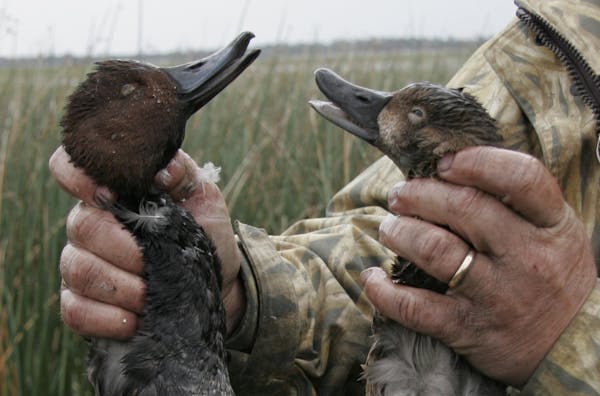When Minnesota duck hunters slipped their boats into the state's 54 designated wildlife lakes over the weekend, they mostly found clear waters full of vegetation — and probably ducks.
Waters such as Pelican Lake in Wright County, which recently was turgid with little vegetation — unattractive conditions for waterfowl.
"It's crystal clear now,'' said Fred Bengston, Department of Natural Resources area wildlife manager. "It looks like a northern Minnesota lake. The vegetation is thick.''
The rejuvenation brought hunters and ducks to the lake on Saturday.
"I checked one group of seven that had 30 ducks, mostly blue-winged teal,'' conservation officer Rick Reller said. "They had a great hunt.'' Reller counted about 90 vehicles at the public accesses to the 3,800-acre lake.
Water conditions there have improved dramatically following a 2014 major fish kill, and lake levels are being drawn down as part of a $2 million project to improve water quality and wildlife habitat. "It's just going to get better for waterfowl,'' Reller said.
Pelican is among the state's 54 wildlife lakes, legal designations that allow the DNR to temporarily lower lake levels without seeking permission from all of the shore landowners, and to regulate watercraft use. Those lakes cover 55,000 acres and range in size from 48-acre Lake 14 in Big Stone County to 9,000-acre Swan Lake in Nicollet County.
The law establishing the program was approved by the Legislature in 1969, at the urging of the newly formed Minnesota Waterfowl Association.
"That was the reason the Waterfowl Association was founded,'' said Brad Nylin, executive director. Those shallow lakes provide key nesting, resting and feeding areas for waterfowl, and the MWA founders knew if the state was to have ducks, those "game lakes'' needed to be restored. The program initially was limited to southern Minnesota waters but later was expanded to include the entire state.
Manipulating water levels is a key to improving habitat on many shallow lakes, said Nicole Hansel-Welch, DNR shallow lake program supervisor. Because of historic ditching and draining, many of the state's shallow lakes aren't so shallow anymore.
Natural drought cycles rejuvenate shallow lakes, compacting sediment, killing off unwanted fish, including carp, which results in improved water quality, increased vegetation and more invertebrates.
The DNR attempts to mimic that process with water-control structures, and sometimes even pumps, to periodically reduce water levels, Hansel-Welch said.
Those efforts are working, she said. Famed Lake Christina's long-sick waters have been improved by a $2.3 million pumping system installed in 2012 that allowed the DNR to lower water levels. Smith Lake in Wright County, Lake Maria in Murray County, Swan Lake in Nicollet County and Lake Geneva in Freeborn County all have responded to water-control efforts, Hansel-Welch noted.
"When I started, Geneva was turbid and looked terrible,'' she said. "Now it's full of wild celery, and full of ducks.''
Designating lakes is one thing, but having the funds to build and operate water-control structures is something else. Though Lake Christina was designated a wildlife lake in 1983, it wasn't until recently that the funds were available to construct the complicated pumping system. Passage of the Clean Water, Land and Legacy Amendment in 2008 has provided that funding.
In Lake Christina's case, $1.5 million of the $2.3 million project were Legacy dollars. Those same dollars also have funded several other recent shallow lake projects, including the $2 million Pelican Lake project in Wright County.
The number of designated wildlife lakes has been growing. "We added six last year, the most ever,'' Hansel-Welch said.
The process is lengthy and complicated, requiring internal and external reviews, a public hearing and permits. "It can take a couple of years,'' she said.
Besides having authority to lower water levels, designation allows the DNR to regulate motor use. Air boats are prohibited on all 54 designated lakes, and some lakes have other restrictions, including horsepower limits, electric motors only, or no motors — to reduce duck disturbance and protect aquatic vegetation. Those restrictions are posted at access points. Other than the air boat ban, some other designated lakes have no motor restrictions.
Meanwhile, at Pelican Lake in Wright County, the DNR continues to lower water levels, and the next phase of the project, set to begin soon, will speed the process, which should benefit ducks and duck hunters.
"It's just going to get better,'' Reller said.
Doug Smith • 612-673-7667

